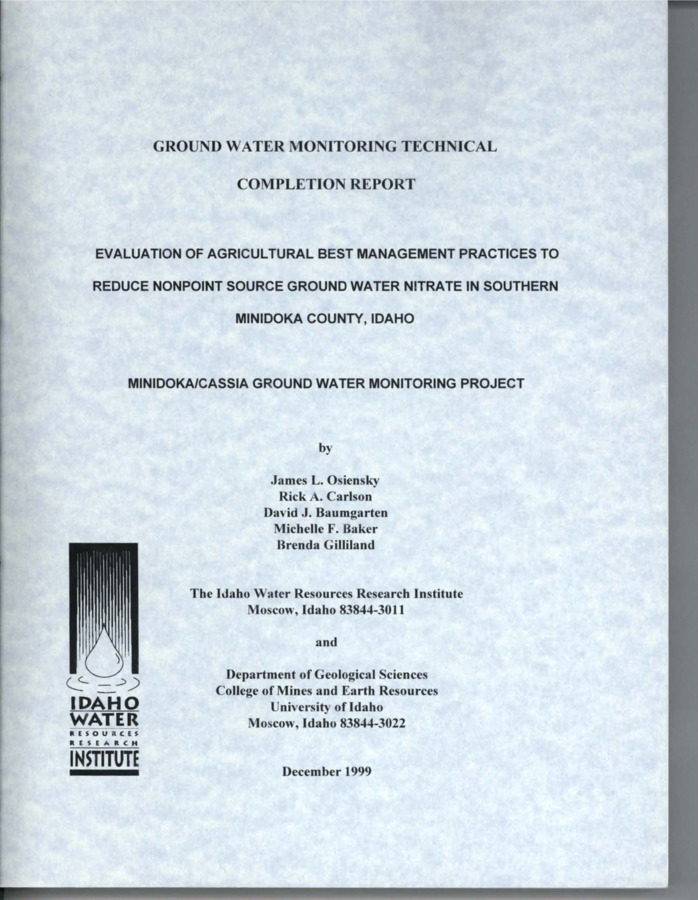PDF
Evaluation of agricultural best management practices to reduce nonpoint source groundwater nitrate in southern Minidoka County, Idaho. Groundwater monitoring technical completion report Item Info
- Title:
- Evaluation of agricultural best management practices to reduce nonpoint source groundwater nitrate in southern Minidoka County, Idaho. Groundwater monitoring technical completion report
- Authors:
- Osiensky, James L.; Carlson, Rick A.; Baumgarten, David J.; Baker, Michelle F.; Gilliland, Brenda
- Date:
- 1999-12
- Description:
- In 1992, the EPA Section 319 National Monitoring Program (NMP) provided funding for the establishment of two demonstration fields within the Idaho Snake River Plain Water Quality Demonstration Project area in southern Minidoka County. A demonstration field was selected at each of two farms for a pilot groundwater project primarily to monitor potential nonpoint source groundwater nitrate contamination and to evaluate the effectiveness of two United States Department of Agriculture (USDA) recommended Best Management Practices (BMPs): (1) a nutrient management BMP through crop rotation and (2) a nutrient management BMP through reduced irrigation water application. An EPA suggested paired watershed approach was used to evaluate independently a different BMP at each demonstration field. For the paired watershed approach, each field was split into a control half and treatment half, and two periods of study were evaluated, a calibration period and a treatment period. The focus of this investigation was to evaluate MBP treatment period effects on groundwater nitrated concentrations in shallow, perched aquifers underlying both demonstration fields, that are highly susceptible to agricultural nitrate contamination. A geostatistical approach was developed to evaluate nitrate concentration distributions and BMP effectiveness. A monitoring network of lysimeters, groundwater point samplers, and/or shallow wells based, in part, on a geostatistical-oriented design was installed at each demonstration field. Monthly nitrate data collected for these monitoring networks were evaluated using two different types of geostatistical approaches. A sequential Gaussian (SGS) simulation approach was used to evaluate groundwater and soil water nitrate concentration distributions at the crop rotation BMP demonstration field (i.e., Forgeon Field). A trend surface analysis (TSA) approach was used to evaluate groundwater and soil water nitrate concentration distributions at the irrigation BMP demonstration field (i.e., Moncur Field). Geostatistically derived spatial maps based on SGS and TSA results were compared using a spatial map subtraction technique to evaluate net nitrate changes at each demonstration field.
- Subjects:
- nonpoint pollution sources groundwater contamination nitrates best management practices
- Location:
- Minidoka County, Idaho; Snake River Basin; Southern Idaho
- Idaho County:
- Minidoka County
- Latitude:
- 42.84
- Longitude:
- -113.58
- Collection:
- Boise Basin
- Source:
- Idaho Water Resources Research Institute, University of Idaho
- Identifier:
- IWRRI Number 199901
- Publisher:
- Idaho Water Resources Research Institute, University of Idaho
- Contributing Institution:
- University of Idaho
- Type:
- Text
- Format:
- application/pdf
- Cataloger:
- KIT
- Date Digitized:
- 2017-09-26
- Language:
- eng
Source
- Preferred Citation:
- "Evaluation of agricultural best management practices to reduce nonpoint source groundwater nitrate in southern Minidoka County, Idaho. Groundwater monitoring technical completion report", Idaho Waters Digital Library, University of Idaho Library Digital Collections, https://www.lib.uidaho.edu/digital/iwdl/items/iwdl-199901.html
Rights
- Rights:
- In copyright, educational use permitted. Educational use includes non-commercial reproduction of text and images in materials for teaching and research purposes. For other contexts beyond fair use, including digital reproduction, please contact the University of Idaho Library Special Collections and Archives Department at libspec@uidaho.edu. The University of Idaho Library is not liable for any violations of the law by users.
- Standardized Rights:
- http://rightsstatements.org/vocab/InC-EDU/1.0/

